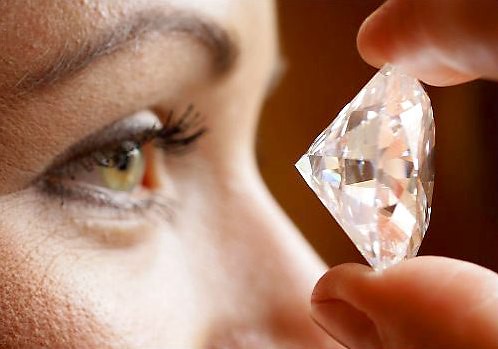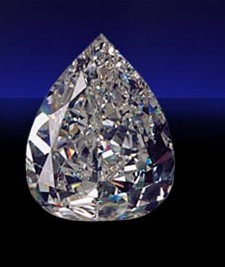The Millennium Star

the millennium star diamond
De Beers and the Steinmetz Group has unveiled the world's rarest and arguably the most valuable set of diamonds ever put together to mark the year 2000. Stressing that 'millennia come and go, but diamonds are forever,' the diamond giant's Chairman Nicky Oppenheimer presented the De Beers Millennium Star, a D-color, internally and externally flawless pear-shape, cut to perfect proportions, weighing a hefty 203.04 carats. It is the second largest faceted D-Flawless diamond in the world, the 273.15 carat Centenary Diamond is the first.
The Millennium Star is the centerpiece of the company's Limited Edition Millennium Diamonds collection which further consists of 11 highly unusual blue diamonds cut into a variety of shapes, having a total weight of 118 carats. The diamonds were presented to the world with great theater during an impressive ceremony at the top floor of the CSO's Charterhouse Street complex in London: the Millennium Star was lovingly caressed by the latest James Bond girl, French actress Sophie Marceau, under the approving eyes of De Beers top executives and principals of the worldwide Steinmetz Group of Companies - the craftsmen that designed, planned, and manufactured these exceptional and unique stones.
The team of cutters, who labored in polishing the collection for some three years around the clock, was headed by Israeli-born Nir Livnat, managing director of Johannesburg-based Ascot Diamonds, a member of the Steinmetz Group of Diamond Companies. The Steinmetz Group is known as 'the master' in the field of diamonds and is one the leading customers of De Beers. The Steinmetz Group has several sources of independent mines which supply the rough diamonds. Whenever a large sale, auction or event appears in the diamond business, you can be sure that the Stieinmetz Group is part of it. The Steinmetz Group supports Diamond.com as the Jeweler of the Millennium Diamonds.
Though the general press coverage focused understandably on the Millennium Star and actress Sophie Marceau (who played in the James Bond movie aptly called "The World is Not Enough"), the trade is rightfully excited also about the eleven exceptionally rare blue diamonds, which orbit as sparkling blue satellites around the Millennium Star. Steinmetz explains that each one of these stones came from the famous Premier Mine in South Africa. But blue diamonds of this quality and size are extremely rare and to discover one on any year is an incredible accomplishment, let alone discovering the entire collection. In addition to the pear-shaped Millennium Star, the collection consists of 11 beautiful blue diamonds of different shapes and carat weights, ranging in size from 5.16 carats to a phenomenal 27.64 carat heart-shaped stone, the Heart of Eternity. Each of these 11 blue diamonds will be specially inscribed with a De Beers Millennium number, using De Beers' proprietary branding technique. Livnat explains that the Millennium Star will not be branded, as "it is externally flawless. There is not even a single scratch or burn mark on any of the facets. This is extremely exceptional - and a tribute to the cutters' expertise - and De Beers is therefore rightfully presenting the stone as externally flawless." Thus branding is out for the Millennium Star.

It is expected that some 12-million people will visit the De Beers Millennium Jewels Exhibition at the new Millennium Dome in London. There they will remain on view in a specially designed exhibit for the entire year. It is worth it to pause a moment and reflect on the rarity of blue diamonds. Pre-20th century accounts of great blue diamonds reinforce the trade's historical links with India, the only known early source of diamonds. These accounts tell of diamonds such as Tavernier Blue (now known as the Hope Diamond; 45.52 carats) and the 30.82-carat Blue Heart, which today are valued for their history and mystique as much as for their rare color. These diamonds are famous because of their incredible rarity - only red diamonds are rarer - and the De Beers collection of blues is something that will never be seen again.
In modern times, De Beers Premier mine in South Africa has become the only important source of blue diamonds, yet they make up much less than 0.1 percent of all diamonds recovered at this mine. Of all De Beers South African rough production, however, there is on average only one significant blue diamond mined per year. The best blue diamonds have a beauty that is not comparable to that of any other gem. These are greatly admired and eagerly sought after by collectors and connoisseurs. Of the ten highest per-carat prices paid for colored diamonds at auction, six have been blue diamonds. Some of these unique stones were sold for $550,000-$580,000 per carat. One 20 carat blue stone fetched well in excess of $10 million. "Fancy blue diamonds contain impurities of boron, which result in their blue color. Usually the blue of a diamond is strongly modified by gray or black. Few stones have intense, saturate color," explains Livnat, stressing that "the blue color is often not evenly spread throughout the stone and that, occasionally, parts of a blue stone may be totally white. To get a beautiful pure blue stone is truly a professional challenge."
Natural blue diamonds are much weaker in saturation than the blue objects they are compared to. Blue colors are not overly abundant in nature, although they do occur in certain flowers, fruits, birds, and gemstones. Actual diamond blues, however, are more likely to mimic the blue colors of indigo, ink and steel. Whatever term is used to describe blue diamonds, it is their combination of color, brilliance and rarity that makes them so special. The rough diamond was found by an alluvial digger in the early nineties. It originated in what was then known as Zaire, now the Democratic Republic of the Congo, and was purchased there many years ago by a De Beers buyer on the open market. The stone has been held in deliberate anticipation of this moment, though its polishing took more than three years. Its beauty has now been released by the extraordinary skill of the expert craftsmen, and international team (South African, Israeli, Belgian & American). The cutters received the ultimate compliment when former De Beers Chairman, the late Harry Oppenheimer, undoubtedly the doyen of the diamond industry and who has probably handled more important diamonds in his 70-year career than any other person in the world, described the Millennium Star as "the most beautiful diamond I have ever seen."

Actress Sophie Marceau holding the Millennium Star.